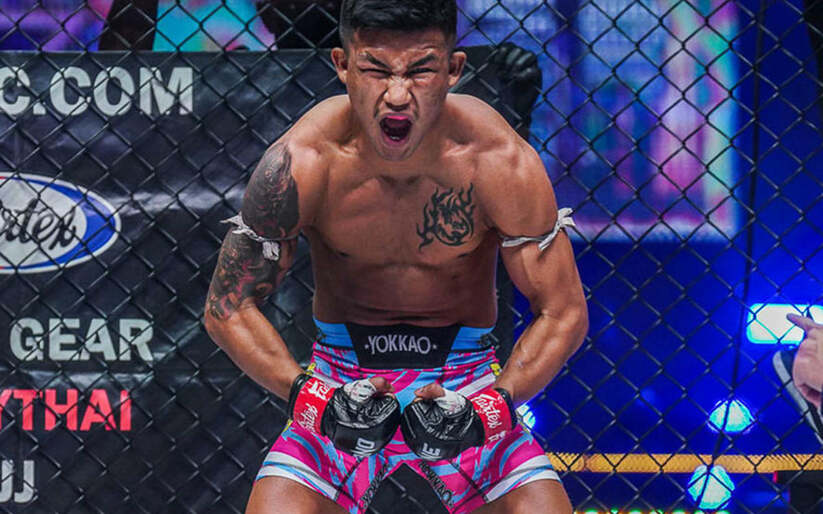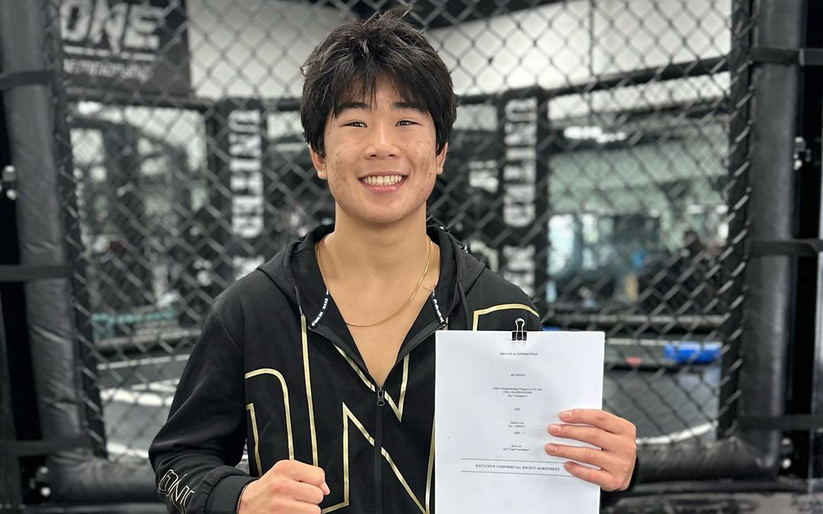Wherever Yoel Romero goes, chaos is sure to follow. Whether it’s through stool-related incidents, missing weight before damaging an opponent’s brain, or merely slipping and sliding under the force of his own absurd acceleration, Romero has a penchant for mishaps. The man is a walking embodiment of the phrase “These things happen in MMA.”
It came as little surprise when Romero failed to make weight for the middleweight title fight headlining UFC 225. Instead, his long-anticipated rematch with Robert Whittaker turned into an almost-title fight in which one party was ineligible to win the middleweight belt, with the other unable to lose it.
Robert Whittaker vs. Yoel Romero Breakdown: Agents of Chaos
If in-fight actions can ever make up for mistakes made outside the cage, the main event of UFC 225 provided one hell of a redemption story. Romero absolutely took it to middleweight champion, Robert Whittaker, giving him all he could handle and more. Never one to shy away from adversity, Whittaker battled back admirably, showing both the skill and heart of a champion.
While Whittaker was crowned by the judges’ cards, both men emerged looking like kings. The fight had something for every fight fan. Utter chaos and mind-blowing violence stacked on top of a deep tactical battle with layers of adjustments. Momentum swung back and forth as Whittaker spent long stretches of time picking Romero apart with feints and carefully built setups, before being knocked silly and pounced upon by the Cuban Olympian, only to recover and give almost as well as he got.
Distance Striking
Whittaker came out cautious, working behind his longest weapons in order to extend the distance. Romero seemed intent on giving the early rounds away in order to bank his cardio for explosive bursts late in the fight.
The adjustments made by both men since their first fight gave their rematch a somewhat reversed momentum curve, with Whittaker owning the early rounds and Romero coming on strong late in the fight. Romero’s decision to largely abandon his wrestling proved intelligent, as he avoided burning his energy attempting to control Whittaker.
Romero’s most significant offense on the feet in their first fight came in the form of low-line side kicks. Whittaker stole his kicks for the rematch, going to work with them early and often. The kicks are great against someone like Romero who is looking to step directly forward with committed, explosive bursts, as they jam the lead leg in a straight line. Whenever Romero committed weight to his front leg to move forward, he had to worry about having his knee snapped back.
The low-line side kick is also a great tool to cover an entry and set up further offense, but Yoel was able to defuse Whittaker’s attempts to follow up by covering or threatening counters with his lead hand.
Romero played with a tight high-guard early in the fight that gave Whittaker serious trouble landing clean to the head. Whenever Whittaker entered with punches, Romero would throw his elbows up high and cover his face with his forearms. As difficult as it made hitting his head, his guard left body shots wide open for Whittaker.
The typical high guard makes use of the forearms to cover the face, while the elbows are kept tight to guard against body shots, with upper body and hip movements used to adjust positioning as necessary. Romero keeps his elbows tight to his head, sacrificing any defense of the body. While the large gloves in boxing make it easier to cover the head with the forearms, Romero’s upright stance also hurts his coverage here, leaving a wider surface area for Whittaker to attack.
Near the end of the first round, Whittaker exploited the opening to the body with a lovely combination. He shows the jab to cover his entry and distract Romero up high, before banging the open body twice.
Whittaker also had success using the lead-leg front kick to attack the body. Along with doing damage and sapping an opponent’s gas tank, front kicks work much the same way as the low-line side kicks in that they impede forward movement. Whittaker was able to consistently disrupt Romero’s entries, spearing him on the front kick as he stepped forward.
Luke Rockhold attempted the lead leg front kicks throughout his fight with Romero, but as we covered in our post-fight breakdown, Rockhold’s wide stance prevented him from getting the distance and power necessary to deliver significant force on them. On the other hand, Whittaker spends a lot of time bouncing around on the outside with his feet close together, which allowed him to spring into powerful front kicks at a moment’s notice. Even when he was in the staggered stance necessary for closer-range fighting, Whittaker would sneak his rear foot up to give his lead hip room to open before kicking.
The one downside to relying so heavily on the lead-leg front kick rather than the rear-leg front kicks he used in their first fight is that it doesn’t work as well to set up entries. A consistent feature of Whittaker’s game has been using the rear-leg front kick to convince opponents to back up, before stepping through into southpaw and blasting them with his hands. With the lead-leg kick, the rear leg becomes the planting leg, restricting the kick’s range. Attempting to step forward off a lead-leg kick deep enough to close distance on a retreating opponent will often leave the stance stretched out and make following up difficult.
Although Whittaker found success with his front kicks, they got him into trouble later in the fight as Romero began working out counters.
In the first sequence, Romero takes a slight lateral step as he advances, breaking the line and causing the front kick to graze his body. Without the stopping power of a clean kick to halt Romero’s advance, Whittaker is unprepared to exchange and gets caught as he squares up on exit. In the second sequence, Romero lifts his lead leg up to check the kick, which causes Whittaker’s leg to get tied up on his calf. Whittaker gets caught with a clean combination as he stumbles back off-balance
After largely waiting out the first round, Romero switched his guard up, relying heavily on a cross-armed guard that he utilized against Rockhold. Interestingly, Romero’s hand positioning in the Rockhold fight was strange, with his lead hand on top, which limited his ability to counter out of the guard. His hand positioning was more traditional against Whittaker, with the rear forearm covering the chin and the lead hand held lower, allowing him to hit smooth lead-hand counters as he slipped. Although Romero lacked the level changes and upper-body/hip movements necessary to cover the body from the cross-armed guard, the positioning of his lead hand did make it easier for him to parry the front kicks.
Romero showed an inside leg kick throughout the fight, to which Whittaker would respond by picking his lead leg up high to check and immediately launching a counter. Whittaker’s bladed stance leaves his leg exposed to outside leg kicks, but inside leg kicks tend to find the bone of the shin unless a deep inside angle is taken first. Romero would’ve been better served looking to land the outside leg kick.
Whittaker needs only to pick his leg directly up to check the inside kick, but a kick from outside would punt the raised leg out if he wasn’t given time to turn the shin into it.
The outside leg kick landed with great effect the few times Romero threw it. He was able to punt out Whittaker’s lead leg from a southpaw stance late in the fight, knocking Whittaker into an inferior angle and forcing him to pivot out. As Whittaker popped up from behind his lead shoulder, Romero sent him to the canvas with a devastating lead hook.
Romero would feint the kick in order to get Whittaker picking up his leg before stepping in with a punch, but he was unable to parlay that into consistent success as Whittaker ducked in off his check.
In the Exchange
Whittaker’s striking game is a lovely mix of karate tactics and boxing fundamentals. He’ll bounce around on the outside like a points karateka, before adopting a strong, staggered stance and hitting counters off slips and weaves in the pocket. Whittaker makes great use of the linear point karate game on his entries, often springing in with a leaping jab or lead hook.
These leaping punches present two clear opening – as he comes in, with his momentum leading him into a counter, and a moment after his feet plant, as he recovers his footing from the rapid movement.
Whittaker covers his entries well with feints and takes his head off-line to defuse simultaneous counters. In order to prevent Romero from landing delayed counters as he recovered his footing, Whittaker would frame directly off the jab or lead hook.
After springing in with a hook or jab, Whittaker lays his forearm across Romero’s face or neck. When Romero slips outside or dips under the punch, the forearm is right there and just needs to be brought down. When Whittaker landed the jab, he’d thrust out another quick one to get his forearm in position to immediately cross-face. The frame keeps Romero’s weight on his rear foot and prevents him from transferring weight into a counter while Whittaker exits safely. Derek Brunson had success using the same tactic against Romero.
While Whittaker had trouble finding Romero’s face early as the Cuban was intent on covering up and avoiding exchanges, Whittaker began landing counters as soon as Romero opened up.
Whittaker had been trying to build off his jab and lead hook in the first round, but the shots mostly fell on Romero’s guard. When Romero opened up and started punching with him, Whittaker began landing his jab while dipping under the returns.
Romero made several sharp adjustments to take away Whittaker’s dipping jab, however.
Romero skips into a knee as Whittaker dips down to his right. The knee doesn’t land and serves mostly to push Whittaker away with the leg, but raising the knee disrupts his entry and prevents him from following up on the jab.
Romero would also look to catch Whittaker dipping with uppercuts. The threat of a wound-up Romero uppercut is undoubtedly enough to dissuade most human beings from dropping their level.
These tactics effectively dissuaded Whittaker from dipping with his jab on entry. Instead of abandoning his defense, however, Whittaker adjusted in response. Instead of changing level severely, he would maintain a more upright stance while jabbing and use the rear hand to cover the right side of his face, while his lead shoulder protected his chin.
This lead to a couple brilliant shoulder rolls in the fourth round.
Elbows from Hell
It’s often said that a champion is defined by their ability to pick themselves up off the canvas and get back to work in the face of adversity. That statement encapsulates what makes Whittaker’s performance so special. After getting rocked multiple times and beat up badly in the third round, Whittaker not only had the composure and presence of mind to keep himself safe and hold out, but the will and heart return the punishment.
Amidst Romero’s flurrying, Whittaker consistently frames his face away to prevent him from landing. He would elbow directly out of the crossface, or collapse the frame and let Romero move his head straight onto an elbow. Here he also hits a sweet Thai-style diagonal elbow as Romero pops up from a failed takedown.
Whittaker did a superb job tying Romero up in the clinch to stop the onslaught. Whenever Romero dug his head in or framed off to pull his hands free and hit, Whittaker would attempt to slot an elbow in before pummeling inside to tie up Romero’s arm in an overhook.
As a side note, the cross-armed guard Romero relied upon works well for defending elbows to the head, although it was developed for the sport of boxing.
Whereas a high guard can be split by an uppercut elbow or a downward slashing elbow, a forearm across the face will stop any forearm or elbow that travels directly into its path. Romero started using the cross-armed guard well before Whittaker had success with his elbows so it likely wasn’t a direct adjustment, but it still allowed him to mitigate the punishment he took from Whittaker’s elbows.
This style of blocking is common in Muay Thai. You won’t see the cross-armed guard used the way it is in boxing, but Thai fighters will often throw up a quick cross-block to deflect an elbow. It also leaves the defender in strong position to counter with his own elbow.
The Later Rounds
After a difficult and painful third round, Whittaker came out strong in the fourth, picking up the volume and picking Romero apart throughout most of the round.
Whittaker committed to attacking with a lead-leg high kick early in the round.
Although they didn’t land clean, these high kicks still serve several purposes. First, they keep Romero’s rear hand pinned to his head. Any moment Romero spends with his hand tight to his head is a moment he can’t spend punching you in the face. They also serve to damage the arm and can hamper the opponent’s ability to throw punches off the same side if the damage is severe enough. Whittaker also found success throughout the fight hiding a rear-leg high kick behind his rear straight, which is a tactic he used to finish Derek Brunson and Ronaldo “Jacare” Souza.
Romero tightened up his counterpunching late in the fight as Whittaker became more aggressive. Romero would take the punches on his forearms and immediately return with a left hook, even wobbling Whittaker near the end of the fourth round as he got over-aggressive shifting forward.
After a strong showing at the end of the fourth round, Romero owned the final round. He stormed out of the gate and stumbled Whittaker with a straight right early, before dropping him shortly after with a lead hook. Whittaker shelled up on the ground and held onto a leg for dear life, managing to build his base and get back to his feet in an incredible display of grit. Whittaker was able to largely mitigate the damage he took from the halfway point on, outside a hard knee and a handful of punches, but his offensive output throughout the round was sparse and insignificant.
Key Takeaways
The most important thing to take from this fight is that Robert Whittaker and Yoel Romero are absolute warriors who likely just put on the best fight the UFC’s middleweight division has ever seen. Both men put their bodies on the line for glory and sport, fighting as hard as they did smart.
Whittaker suffered a broken thumb early in the first round, which marks both his second injury in two fights with Romero, and his second hand injury in as many years. Two years earlier, Whittaker broke his hand on the first exchange against Rafael Natal. The hand injuries could prove to be a persistent problem for him going forward. The cross-armed guard Romero was playing with is liable to damage the opponent’s hands by projecting the elbow onto punches, but curiously the injury came in the first round before Romero adopted the guard.
It’s hard not to have questions about scoring coming out of UFC 225, which saw plenty of strange scorecards turned in.
Perhaps the most pressing question is – what do you have to do to get a 10-8 round? Nobody really seems to know. Under the unified rules, a 10-8 round is defined as one in which “one fighter wins the round by a large margin.” If one fighter has “dominated the action of the round,” has “duration of the domination,” and also significant “impact,” a 10-8 score is not only recommended, but absolutely required.
Conversely, a 10-9 round is defined as one in which “one combatant wins the round by a close margin.” It seems impossible to argue that Romero didn’t thoroughly satisfy the criteria for a necessary 10-8 in the fifth round, which would have left the fight a draw on the judges’ cards.
Regardless of scoring debates, perhaps it’s for the best that Whittaker emerged victorious. With his weight issues and ineligibility to win the belt, a Romero win would have plunged the middleweight title picture back into the chaos from which Whittaker only recently dug it out. With a Whittaker win, the title is stabilized and a trilogy fight between the two can be set up at a later date if Romero is able to stay on weight and pick up some wins in the meantime.
Either way, what transpired in the main event of UFC 225 is the stuff legends are made of.
Main Photo
Embed from Getty Images




That was an awesome breakdown. Thanks for sharing. This is as good as some of the more “famous” breakdowns. I wish you the best.
Couldn’t agree more Gary, Ryan is as good as the best of them.
Thanks a lot man, I really appreciate it.